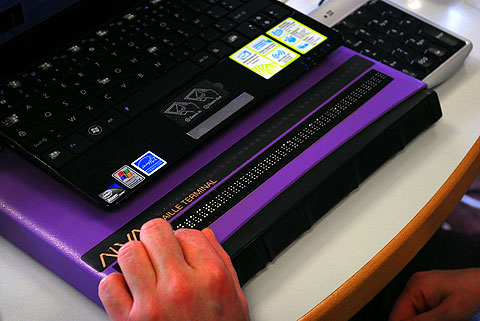Visual disability
Blind persons
Main difficulties encountered
Blind people will encounter difficulties with:
- all types of non-text content (images, information given only by colour, video, etc.);
- the perception of the structure of the information and the content proposed to them and to which they have sequential access (tables, lists or identification of the main areas of the page, etc.);
- the use of interactive elements: form elements, JavaScript-rich components (tab system, modal window or input calendar) and moving content or dynamic insertion of content into the page.
Assistive technologies
Blind people access the content and features of a website or web application through a screen reader that:
- vocalizes the contents and some of their properties,
- offers sophisticated navigation features (specific keyboard shortcuts in particular),
- and supports all interactions with interactive elements.
A screen reader is a complex software to use that requires a learning phase. It can be optimized through parameters designed to increase its efficiency and adapt it to the user’s capabilities.
Video demonstration of a screen reader
In addition to the screen reader, blind braillists can use a Braille terminal to access content and interact with it more quickly.

Visually impaired persons
The term visually impaired includes a wide range of visual impairments related to many vision disorders.
Without aiming at exhaustiveness, we can distinguish visually impaired people who:
- do not see colours, certain colour combinations or which have difficulties in perceiving contrasts;
- have reduced visual acuity;
- suffer from particular types of visual impairment such as loss of peripheral vision or, conversely, loss of central vision, which cause serious reading or locating difficulties in the page.
Main difficulties encountered
These people will encounter difficulties with:
- the information given only by color,
- the lack of contrasts,
- the use of imperceptible colours or combinations of colours (e. g. green and red for color-blind people with deuteranopes),
- the size of the characters.
Color blindness demonstration, Visual impairment demonstration
Assistive technologies
To overcome their difficulties, they can use devices that allow them to:
- to increase the contrasts,
- to choose colour combinations that are perceptible to them,
- adapt the font size (reduce or enlarge) to their needs,
- to enlarge the screen using screen magnifiers, possibly coupled with voice systems or the character enlargement features of their browser.
Sources: Impacts on users
